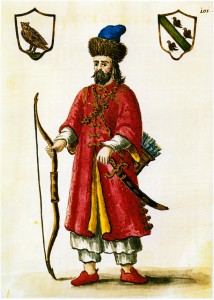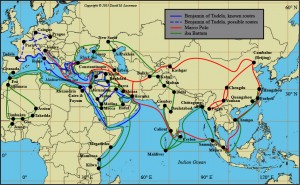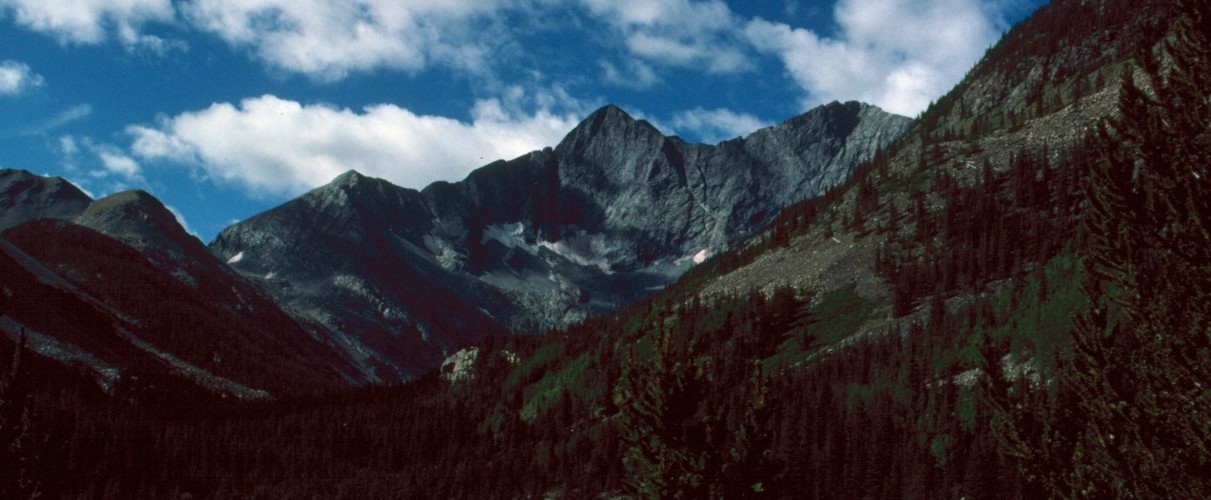The Travels of Marco Polo

Marco Polo in Tartar costume (n.d.: Source: http://commons.wikimedia.org/wiki/File:Marco_Polo_-_costume_tartare.jpg).
MECHANICSVILLE, Va.—I think it’s safe to say that Marco Polo was the most famous European explorer prior to Columbus.
He has to have been, in any event, as his Travels of Marco Polo was one of the biggest motivations for the great Age of Discovery. For better or worse, Polo’s Travels inspired legions of would-be explorers—including Columbus—to go off in search of tremendous wealth in China and the other eastern empires that Polo described.
Polo was a Venetian merchant whose father, Niccolò, and uncle Maffeo departed on a trade trip to Constantinople before Marco was born in 1254. By the time Niccolò and Maffeo returned to Venice in 1269 on a mission from Kublai Khan—a.k.a. The Great Khan, Genghis Khan’s grandson and founder of China’s Yuan Dynasty—Niccolò’s wife had died and Marco was being raised by another uncle and aunt.
In 1271, Niccolò and Maffeo departed on their return trip to China, taking Marco with them. This journey, which lasted 24 years, is the one recounted in the Travels.

Map of the routes taken by several Middle Age explorers of the Old World. Tracks in blue are those of the twelfth century Jewish explorer Benjamin of Tudela; tracks in red are of the thirteenth century Christian explorer Marco Polo; and tracks in green are of the fourteenth century Muslim explorer ibn Battuta. The religions of the explorers are important, as each man viewed the the lands and seas he traveled through with a different cultural lens. Redrawn from other sources. Mercator Projection with a nominal scale of 1:67,500,000.
In short, the Polos sailed to Acre to pick up a couple of priests, Nicholas of Vicenza and William of Tripoli, who were to accompany them and represent Pope Gregory X on their mission to Kublai Khan’s court (but who found excuses to double-back at the earliest opportunity). They then sailed north to the port of Laiassus—near the modern-day city of İskenderun on Turkey’s eastern Mediterranean coast—then proceeded by land across Armedia and Persia, where they joined the Silk Road and followed it east to eventually reach The Great Khan’s capital at Cambaluc (modern-day Beijing).
Over the next two decades the Polos assisted The Great Khan with administration of the Yuan state, going on diplomatic missions—including one to the Kingdom of Pagan in what is now Burma—and educating Kublai Khan on European ways and the Christian religion.
In time, though, they had a reasonable fear of political instability within the Yuan Dynasty. Fearing what might happen should Kublai fall from power, they sought an excuse to return home, and eventually found it in an opportunity to escort the Mongol princess Kököchin to Persia, where she was to marry the Ilkhanate Khan Argun. By the time they arrived, Argun was dead. Kököchin instead married his son Ghazan.
The Polos then returned to Venice. Shortly afterward, Marco Polo joined the Venetian Navy in a war with Genoa. He was captured, and dictated the story of his travels to his cellmate, Rustigielo of Pisa, while the two were held as prisoners of war.
The Travels of Marco Polo is organized into a four books. The first details the Polos’ journey to the court of Kublai Khan. The second book describes the Khan’s capital, court, and government, as well as describes the provinces Marco visited while serving at the Khan’s court. The third book discusses Japan, southern India, and the islands of the Indian Ocean. And the fourth book recounts wars among the various Mongol Princes, including The Great Khan, the Ilkhanate Khan, the Chagatai Khan, and the leader of the Golden Horde. It also includes a discussion of the “northern” lands in what would now be called Russia, Mongolia, and Central Asia.
The Travels has its flaws. For example, Marco was dictating this tale nearly three decades after his adventures began. He also may have added material he had gleaned from other sources to supplement his own observations. Rustigielo likely introduced some of his own “insights” into the manuscript.
Polo all-too-frequently gives short shrift to his descriptions of other cultures, frequently describing smaller ethnic groups he encountered as “idolaters,” for example. (I suspect his observations are snap judgments resulting from having little time to spend in some of these areas.) He is also sometimes given to unavoidable fantasy, such as in his frequent references to Prester John, the mythical Christian king of Central Asia. Marco never claims to have visited the court, even the realm, of Prester John, but he clearly believes, like many Christians of that time, that Prester John existed.
But The Travels of Marco Polo is rich in detail. Polo describes the organization of the Kublai Khan’s government and army, how it collects revenues—especially from industries such as the salt trade—and how the Yuan court efficiently communicates with far-flung parts of the empire. Marco offers exquisite descriptions on the Yuan Dynasty urban and rural geography, such as in this description of the city of Kin-sai (modern Hangzhou):
… According to common estimation, this city is an hundred miles in circuit. Its streets and canals are extensive, and there are squares, or market-places, which, being necessarily proportioned in size to the prodigious concourse of people by whom they are frequented, are exceedingly spacious. It is situated between a lake of fresh and very clear water on the one side, and a river of great magnitude on the other, the waters of which, by a number of canals, large and small, are made to run through every quarter of the city, carrying with them all the filth into the lake, and ultimately to the sea. This, whilst it contributes much to the purity of the air, furnishes a communication by water, in addition to that by land, to all parts of the town. …
It is commonly said that the number of bridges, of all sizes, amounts to twelve thousand. Those which are thrown over the principal canals and are connected with the main streets, have arches so high, and built with so much skill, that vessels with their masts can pass under them. At the same time, carts and horses are passing over, so well is the slope from the street graded to the height of the arch. If they were not so numerous, there would be no way of crossing from one place to another. …
There are within the city ten principal squares or market-places, besides innumerable shops along the streets. Each side of these squares is half a mile in length, and in front of them is the main street, forty paces in width, and running in a direct line from one extremity of the city to the other. It is crossed by many low and convenient bridges. These market-squares are at the distance of four miles from each other. In a direction parallel to that of the main street, but on the opposite side of the squares, runs a very large canal, on the nearer bank of which capacious warehouses are built of stone, for the accommodation of the merchants who arrive from India and other parts with their goods and effects. They are thus conveniently situated with respect to the market-places. In each of these, upon three days in every week, there is an assemblage of from forty to fifty thousand persons, who attend the markets and supply them with every article of provision that can be desired. …
Each of the ten market-squares is surrounded with high dwelling-houses, in the lower part of which are shops, where every kind of manufacture is carried on, and every article of trade is sold; such, amongst others, as spices, drugs, trinkets, and pearls. In certain shops nothing is vended but the wine of the country, which they are continually brewing, and serve out fresh to their customers at a moderate price. The streets connected with the market-squares are numerous, and in some of them are many cold baths, attended by servants of both sexes. The men and women who frequent them, have from their childhood been accustomed at all times to wash in cold water, which they reckon highly conducive to health. At these bathing places, however, they have apartments provided with warm water, for the use of strangers, who cannot bear the shock of the cold. All are in the daily practice of washing their persons, and especially before their meals (Polo 1926, 232-235).
Marco is equally detailed in the description of Chinese cultural practices, such as in the minting and circulation of paper money in China:
In the city of Kanbalu is the mint of the Great Khan, who may truly be said to possess the secret of the alchemists, as he has the art of producing money by the following process.
He causes the bark to be stripped from those mulberry-trees the leaves of which are used for feeding silk-worms, and takes from it that thin inner rind which lies between the coarser bark and the wood of the tree. This being steeped, and afterwards pounded in a mortar, until reduced to a pulp, is made into paper, resembling, in substance, that which is manufactured from cotton, but quite black. When ready for use, he has it cut into pieces of money of different sizes, nearly square, but somewhat longer than they are wide. Of these, the smallest pass for a half tournois; the next size for a Venetian silver groat; others for two, five, and ten groats; others for one, two, three, and as far as ten bezants of gold. The coinage of this paper money is authenticated with as much form and ceremony as if i were actually of pure gold or silver; for to each note a number of officers, specially appointed, not only subscribe their names, but affix their seals also. When this has been regularly done by the whole of them, the principal officer, appointed by the Majesty; having dipped into vermilion the royal seal committed to his custody, stamps with it the piece of paper, so that the form of the seal tinged with the vermilion remains impressed upon it. In this way it receives full authenticity as current money, and the act counterfeiting it is punished as a capital offence.
When thus coined in large quantities, this paper currency is circulated in ever part of the Great Khan’s dominion; nor does any person, at the peril of his life, refuse to accept it as payment. All his subjects receive it without hesitation, because, wherever their business may call them, they can dispose of it again in the purchase of merchandise they may require; such as pearls, jewels, gold, or silver. With it, in short, every article may be procured (159-160).
I find it hard to overly praise the value of The Travels of Marco Polo as a way for a westerner to gain insight into Chinese history and geography during what we call the Medieval period. The Travels is essential reading for anyone interested in travel writing—even for academics interested in writing modern accounts of the geography of specific readings. Sure, some of Marco’s cultural biases may have crept in, but I find his eye for geographical detail—both physical and cultural detail—and his storytelling skill to be impeccable.
Likewise, I find it hard to overly praise the sense of adventure that runs throughout the Travels—it makes me want to drop everything and travel the Silk Road, no matter how dangerous parts of the route may now be.
REFERENCES
Polo, Marco. 1926. The Travels of Marco Polo. Edited by Martin Komroff. Translated by William Marsden. New York: Boni & Liveright Publishing Co.
